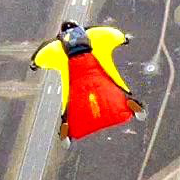Recommended Posts
jimp 1
Problems getting a look at this video, but from the description it sounds much like a jump Natalie Chudiak and I made in 1991 - same location (Volosovo), aircraft (DOSAAF An-2 tail no. 05), and altitude (100 meters or so). Canopy was a standard military D-1-5U static lined and d-bag deployed. Well, it was pretty exciting, and i thought kinda ballsy too, even though a woman had preceeded me out the door!
But, that was nothing.
A couple of years later. I was at an airshow at Zhukovskiy, SE of Moscow. I knew some of the guys were going to make a low static line jump, but was startled when the An-2 came roaring full bore down airshow centre under 200 feet. A stick of 8 jumpers popped out in quick succession, the first on the ground before the last had cleared the aircraft. Canopies were the same standard D-1-5U, everybody had front mounted reserves - what the hell for I don't know. They did another later that afternoon - I had thought of asking to get on the load - something held me back!! so I had to be content with 10 ways out of the Mi-8. One of the guys later said they jump even lower "for practice".
Yeah, crazy Russians allright.
But, that was nothing.
A couple of years later. I was at an airshow at Zhukovskiy, SE of Moscow. I knew some of the guys were going to make a low static line jump, but was startled when the An-2 came roaring full bore down airshow centre under 200 feet. A stick of 8 jumpers popped out in quick succession, the first on the ground before the last had cleared the aircraft. Canopies were the same standard D-1-5U, everybody had front mounted reserves - what the hell for I don't know. They did another later that afternoon - I had thought of asking to get on the load - something held me back!! so I had to be content with 10 ways out of the Mi-8. One of the guys later said they jump even lower "for practice".
Yeah, crazy Russians allright.
Quote
Canopies were the same standard D-1-5U, everybody had front mounted reserves - what the hell for I don't know.
You generally need to have a reserve when you do such jumps from the aircraft - in case the static line was rigged wrong, and you would hung on it. In this case the jumpmaster would cut the static line, then you open your reserve and land it. You do not need a reserve, however, when you do such a jump from the MI-8 helicopter, because it could just land with you safely (well, comparing to AN-2 :))
* Don't pray for me if you wanna help - just send me a check. *
aykay 0
Quotebecause it could just land with you safely (well, comparing to AN-2 :))
Doesnt the AN2 manual state that if pull the stick all the way back it will just sink at a comparable rate to a parachute anyway?
QuoteDoesnt the AN2 manual state that if pull the stick all the way back it will just sink at a comparable rate to a parachute anyway?
Think again! Do you want to be dragged after a landing An-2 when you don't have a reserve and you got stucked on your static line?





Speaking as an Anti-aircraft instructor, I'm afraid that neither of those things will help the plane against modern gear. But actually its much worse that that since the most dangerous ground fire for aircraft in low level flight is not dedicated ant-aircraft weapons but each and every Tom on the ground with a rifle...
Incidentally I was under the impression that the new LLP (Low Level Parachutes) are designed for a 250ft exit.
Not one shred of evidence supports the theory that life is serious - look at the platypus.
Share this post
Link to post
Share on other sites